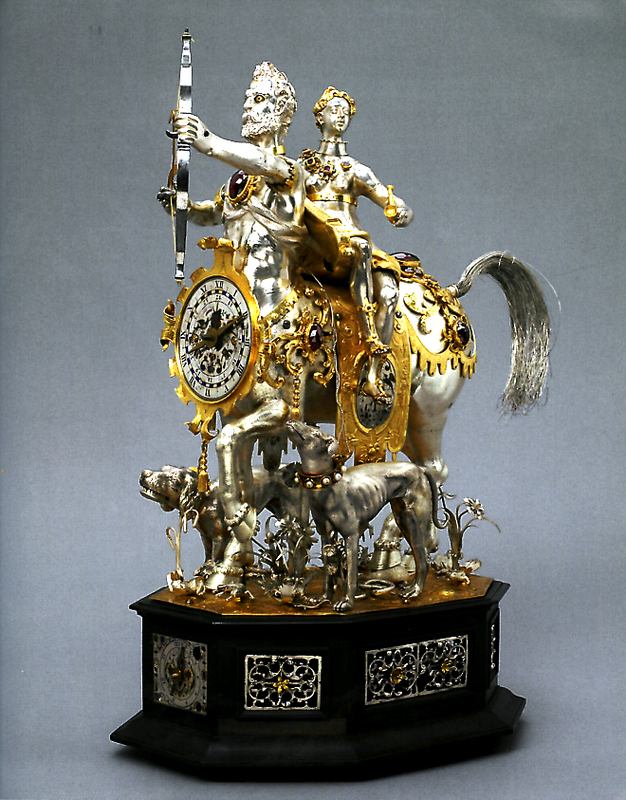Diana on a Centaur

Hans Jakob I Bachmann, Diana on a Centaur, c. 1602/06. Silver partly gilt, partly enamelled, pearls, garnets, wood; mechanism: iron, 39.5 x 32.5 x 18.3 cm. Kunsthistorisches Museum, Vienna, inv. no. KK 1166.
Arresting are his fulvous eyes, as the centaur winds back the bowstring of his gleaming longbow. Atop his back perches a slight Diana, the goddess of the hunt from antiquity. Yet here the goddess holds no weapon but rather a calling horn, and it is as if her mount – the beast, the masculine identity – possesses her hunting prowess. He stands alert with a hoof raised and tail upraised, while she shifts uncomfortably upon the saddle. Below, two hunting dogs, accompany the centaur with their heads raised, pearl chokers at their necks. Their bodies are tensed in the chase, ribs and muscles rippling. Small reptiles and flowers surround them, one particularly vigilant snake coiled and poised to strike beneath the belly of the hound on the centaur’s left. Even in comparison with the canines, Diana seems petite. She is exposed, her breasts bared and framed by a collar of deep garnet inset into gold floral casings above, and a wide golden band below. Upon the centaur’s chest, too, lies a pendant of garnet, yet his garnishment is monumentally larger, almost as if it contained a more forceful vitality. The garnets reappear throughout his ornate caparison, composed of aureate floral forms that mirror those adorning Diana’s chest. Her pubis is demurely covered up by fluttering fabric, while his pelvis supports a large clock-face.
Tick, tock, tick, tock… one can almost hear the clicks reverberating from this large frontispiece, its mechanic quality enhanced only by the dazzling argent surface of the entire centerpiece. Directly below, in the base, lies a clock-like face with unevenly spaced numbers. However, time-telling is not this automaton’s only ability, for it serves as a Trinkspiel, a drinking game (note 1). Inside, a hidden mechanism allows the centerpiece to glide along the table at a predetermined pace. Imagine such a sight inching ever closer down the table: the centaur’s feral eyes rolling, Diana swinging her head from side to side, one hound also turning his head while the other gapes with his mouth. Finally, the centaur releases his golden shaft and the receiver of the arrow must make a toast and finish his glass.
Notes:
note 1. For more on automaton, see Barbara Stafford, Devices of Wonder: From the World in a Box to Images on a Screen. (Los Angeles: Getty Research Institute, 2001), 266-74. See also Lorraine Daston and Katherine Park. Wonders and the Order of Nature, 1150-1750. (New York: Zone Books, 1998), 292-93.